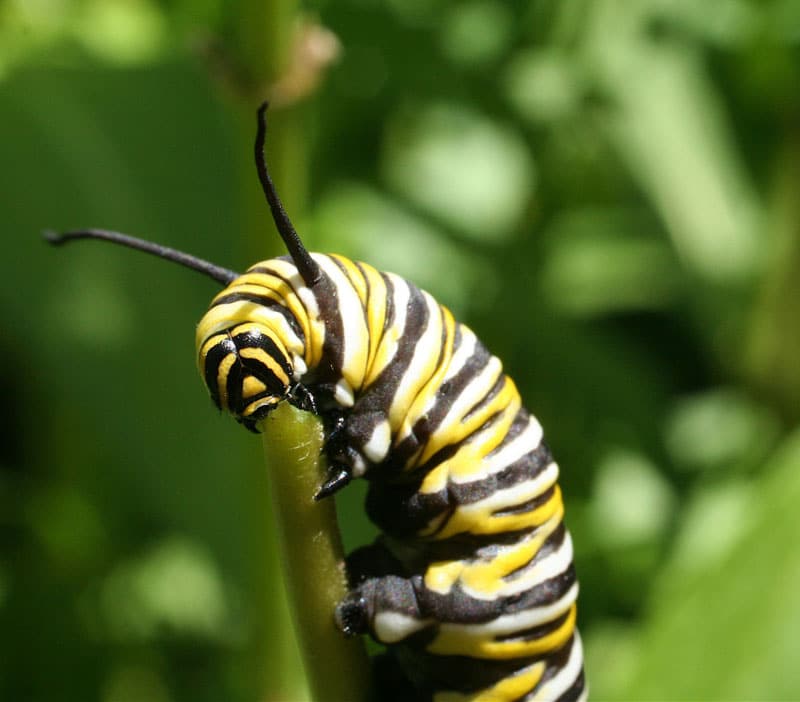
While I’m not an entomologist, I have a deep and abiding love for many insects and their relatives, and plant my gardens with their welfare in mind. When I first began my new Wolfville, N.S., garden, one of the most important perennials I had to have was rosy milkweed (Asclepias incarnate, Zone 3) and several of its relatives. Why? Because I’m fond of monarch butterflies (Danaus plexippus) and monarchs are in decline due to a number of reasons, including habitat destruction. Monarchs are pollinating insects, like bees, and what affects one type of pollinator often affects many others. In order to help monarchs, we need to plant milkweeds.
Monarch butterflies lay their eggs only on various milkweed species, and the developing larvae (the striped caterpillars) eat only milkweeds. Milkweeds contain toxins the caterpillars are able to tolerate, and which make them, and subsequently the adult butterflies, toxic to birds. The adult butterflies can and do take nectar from any number of flowering plants, but they must have milkweeds to continue their life cycle. As a garden writer, I always urge people to plant milkweeds for the sake of monarchs.

I recently wrote a newspaper column about monarchs and milkweeds, and specifically stressed that I don’t encourage people to plant common wild milkweed (Asclepias syriaca), because it’s listed as a noxious weed in many provinces and states. Common milkweed has creeping, perennial rootstocks and also produces large amounts of seed; it can spread quickly in the right conditions, and has been known to be problematic in crop production.
Three other milkweed species, however, are often used as garden perennials and these will also provide hospitality for monarch butterflies. The rosy, or swamp, milkweed I mentioned above has pink or white flowers and grows in a clumping habit, preferring damp areas. Look for ‘Ice Ballet’ if you want the white-flowered form.
Butterfly weed (Asclepias tuberosa, Zone 4) has showy orange or yellow flowers, and prefers dry, well-drained soil. It’s slow to establish and sometimes takes several years to produce flowers. Along with being a slow-to-mature perennial, it’s late to emerge in the spring, so you may want to mark where you plant it to prevent accidentally digging it up the following year.
Whorled milkweed (Asclepias verticillata, Zone 3) has very fine foliage, similar to Arkansas bluestar (Amsonia hubrichtii), and produces clusters of white flowers at the tips of its stems. Like butterfly weed, it prefers dry, well-drained soil and is slow to emerge in the spring. It blooms later in the season and like all milkweeds, is resistant to deer and rabbits.

Planting milkweeds doesn’t guarantee that you’ll have monarch butterflies come to your garden, especially if you have only one plant or a few clumps. But other creatures also thrive on the nectar produced by milkweed flowers, including many types of pollinators, so you’re helping other beneficial creatures with your plantings.
One more tidbit of information for you: the viceroy butterfly (Limenitis archippus) is a non-toxic butterfly found throughout much of North America. With a quick glance, it could be mistaken for a monarch due to its orange and black colouring, but it’s smaller in size. It exhibits a type of natural phenomenon called Müllerian mimicry, in that its resemblance to monarchs is off-putting to birds that might otherwise consider it a food source. Isn’t nature marvellous?
Jodi DeLong
Jodi DeLong, of bloomingwriter.blogspot.ca, is the author of Plants for Atlantic Gardens. Jodi also writes about plants and gardens for Saltscapes magazine and The Chronicle Herald in Halifax.

Leave a Reply